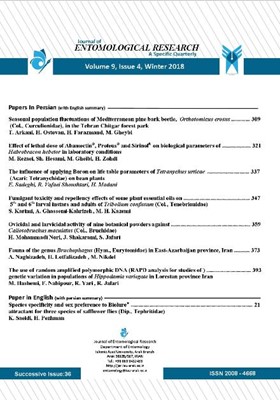Fumigant toxicity and repellency effects of some plant essential oils on 5th and 6th larval instars and adults of Tribolium confusum (Col.: Tenebrionidae)
Subject Areas : entomology and othea arthropodsS. Karimi 1 , A. Ghassemi-Kahrizeh 2 , M. H. Kazemi 3 *
1 - Department of Plant Protection, Tabriz Branch, Islamic Azad University, Tabriz, Iran
2 - Department of Plant Protection, Tabriz Branch, Islamic Azad University, Tabriz, Iran
3 - Department of Plant Protection, Islamic Azad University, Tabriz branch, Tabriz, Iran
Keywords:
Abstract :
The mortality and repellency effects of essential oils of four plants including Myrtus (Myrtus comminus L.), Lindens (Tilia cordata M.), Stachys (Stachys lavandulifolia V.) and Walnut (Juglans regia L.) leaves against 5th and 6th larval instars and adults of Tribolium confusum Duval (Col.: Tenebrionidae) were studied. The essential oil were obtained by hydrodistillation method, using a modified Clevenger-type apparatus. The bioassay experiments were carried out at 27±1 °C and 65±5 % R.H. in dark condition. in Completely Randomized Design with 5 replications after periods of 24, 48, and 72 hours after exposure to essential oils. The repelling effect of the essential oils was tested under darkness condition using Y-tube Olfactometer. The results showed that the Myrtus comminus essence had mortality effects on all three stages, while the other essences had no mortality effects on the pest at very high concentration of 2174 µL/L air. The LC50 values of Myrtus comminus for adults and 5th and 6th larval instars after 24 hours was 181.505, 400.525 and 383.180 μL/L air and after 48 hours these values were 163.935, 378.153 and 362.569 µL/L air. These values after 72 hours were 153.081, 366.746 and 342.052 µL/L air for adults and 5th and 6th instars larvae, respectively. Analysis of variances of the data related to the repellency effects of the studied essential oils (in two concentration of 1000 and 3000 ppm) showed significant differences between three studied stages (P < 0.05). The results of this study showed that the susceptibility of adults to the essential oil of Mirtus comminus was higher than the 5th and 6th instars larvae.
_||_

